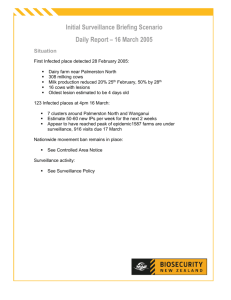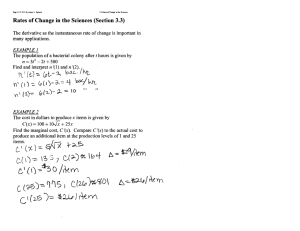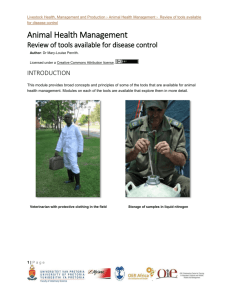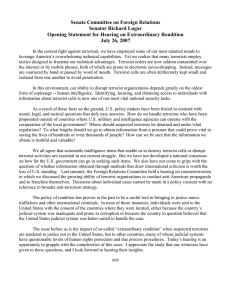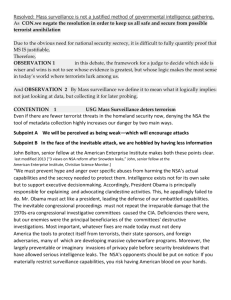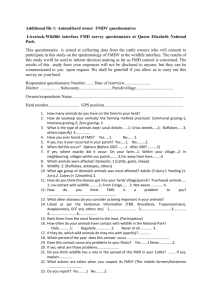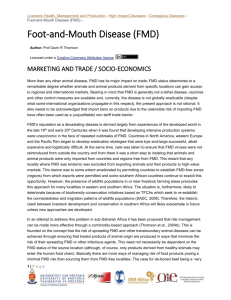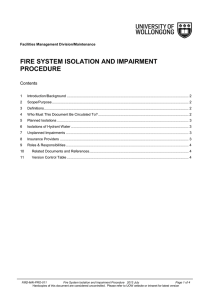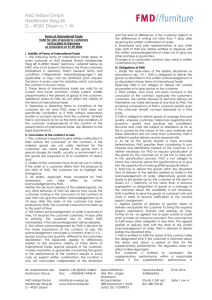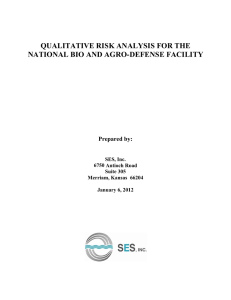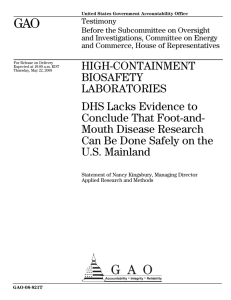Testimony Before the Senate Governmental Affairs Committee by Dr. Thomas... November 19, 2003
advertisement
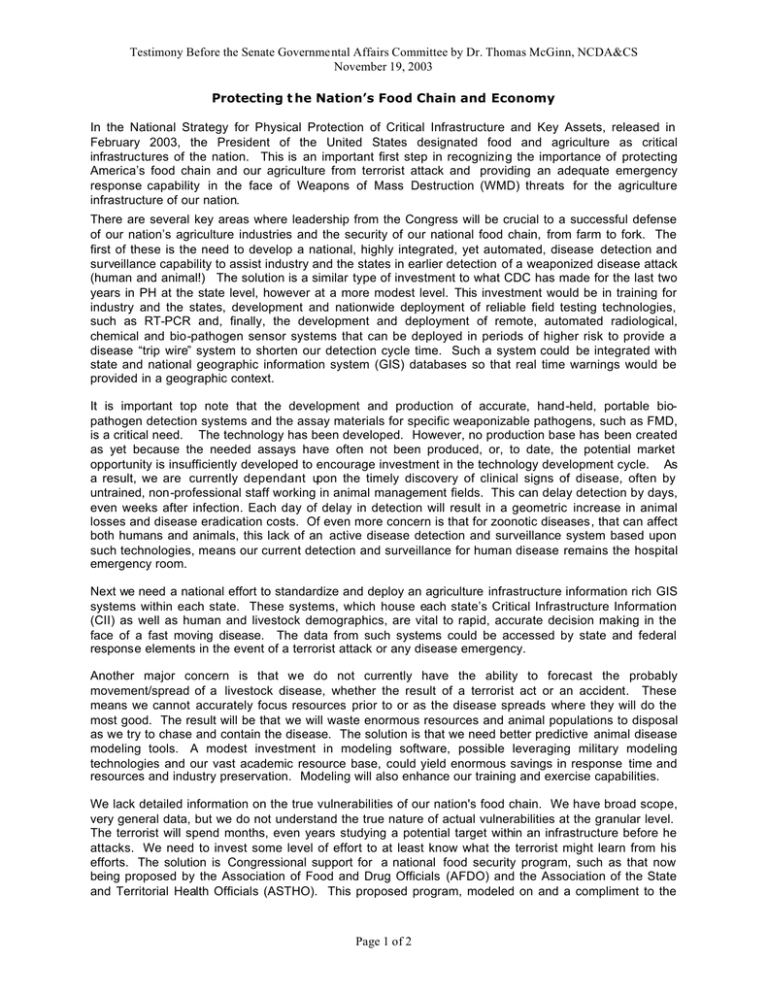
Testimony Before the Senate Governmental Affairs Committee by Dr. Thomas McGinn, NCDA&CS November 19, 2003 Protecting t he Nation’s Food Chain and Economy In the National Strategy for Physical Protection of Critical Infrastructure and Key Assets, released in February 2003, the President of the United States designated food and agriculture as critical infrastructures of the nation. This is an important first step in recognizing the importance of protecting America’s food chain and our agriculture from terrorist attack and providing an adequate emergency response capability in the face of Weapons of Mass Destruction (WMD) threats for the agriculture infrastructure of our nation. There are several key areas where leadership from the Congress will be crucial to a successful defense of our nation’s agriculture industries and the security of our national food chain, from farm to fork. The first of these is the need to develop a national, highly integrated, yet automated, disease detection and surveillance capability to assist industry and the states in earlier detection of a weaponized disease attack (human and animal!) The solution is a similar type of investment to what CDC has made for the last two years in PH at the state level, however at a more modest level. This investment would be in training for industry and the states, development and nationwide deployment of reliable field testing technologies, such as RT-PCR and, finally, the development and deployment of remote, automated radiological, chemical and bio-pathogen sensor systems that can be deployed in periods of higher risk to provide a disease “trip wire” system to shorten our detection cycle time. Such a system could be integrated with state and national geographic information system (GIS) databases so that real time warnings would be provided in a geographic context. It is important top note that the development and production of accurate, hand-held, portable biopathogen detection systems and the assay materials for specific weaponizable pathogens, such as FMD, is a critical need. The technology has been developed. However, no production base has been created as yet because the needed assays have often not been produced, or, to date, the potential market opportunity is insufficiently developed to encourage investment in the technology development cycle. As a result, we are currently dependant upon the timely discovery of clinical signs of disease, often by untrained, non-professional staff working in animal management fields. This can delay detection by days, even weeks after infection. Each day of delay in detection will result in a geometric increase in animal losses and disease eradication costs. Of even more concern is that for zoonotic diseases, that can affect both humans and animals, this lack of an active disease detection and surveillance system based upon such technologies, means our current detection and surveillance for human disease remains the hospital emergency room. Next we need a national effort to standardize and deploy an agriculture infrastructure information rich GIS systems within each state. These systems, which house each state’s Critical Infrastructure Information (CII) as well as human and livestock demographics, are vital to rapid, accurate decision making in the face of a fast moving disease. The data from such systems could be accessed by state and federal response elements in the event of a terrorist attack or any disease emergency. Another major concern is that we do not currently have the ability to forecast the probably movement/spread of a livestock disease, whether the result of a terrorist act or an accident. These means we cannot accurately focus resources prior to or as the disease spreads where they will do the most good. The result will be that we will waste enormous resources and animal populations to disposal as we try to chase and contain the disease. The solution is that we need better predictive animal disease modeling tools. A modest investment in modeling software, possible leveraging military modeling technologies and our vast academic resource base, could yield enormous savings in response time and resources and industry preservation. Modeling will also enhance our training and exercise capabilities. We lack detailed information on the true vulnerabilities of our nation's food chain. We have broad scope, very general data, but we do not understand the true nature of actual vulnerabilities at the granular level. The terrorist will spend months, even years studying a potential target within an infrastructure before he attacks. We need to invest some level of effort to at least know what the terrorist might learn from his efforts. The solution is Congressional support for a national food security program, such as that now being proposed by the Association of Food and Drug Officials (AFDO) and the Association of the State and Territorial Health Officials (ASTHO). This proposed program, modeled on and a compliment to the Page 1 of 2 Testimony Before the Senate Governmental Affairs Committee by Dr. Thomas McGinn, NCDA&CS November 19, 2003 North Carolina Food Security Project, will assist states and industry in an accurate assessment of the vulnerabilities of each component of the nation’s food chain, by commodity. The data gathered would then be assessed and improved response and mitigation plans, vulnerability reduction programs and advanced training and exercise programs would be developed. The resulting vulnerability, all unclassified, along with the risk reduction, response and mitigation plans and the training and exercise programs would be shared with all of the states and industry, as appropriate, to enable reasonable hardening of the entire food chain in accordance with the current level of threat. Next we need to further develop the livestock and plant laboratory system across the nation so that every laboratory can be leveraged to in both the detection and surveillance efforts, as well as disease response. Competent, efficient, standardized and redundant laboratory capacity is key to rapid and accurate diagnosis in the event of any disease emergency, whether human or animal. Even if we discover that a disease, such as FMD, has been introduced to into our cattle or swine (or both) populations, even with early detection by advanced detection technologies, we lack a vaccine production capability or effective vaccine strategies with which to combat a number of potentially weaponizable diseases! Initially, in the case of FMD, we would be almost entirely dependant upon the Europeans for vaccines, until a production cycle can be established in the United States. If there is a simultaneous FMD outbreak in Europe, it is unlikely that we would get that support. The solution is that we must invest now in both the development of vaccines and the creation of a vaccine production base for FMD before such an outbreak occurs. In the area of disease response, containment and eradication, we need a refined national strategy for preparedness and response to any attack on the farm to fork infrastructure that is based upon national policy guidance, resources and standards, but with response and mitigation based upon a public-private partnership at the state and local level. This strategy must integrate DHS, USDA, FDA and NDMS with state and county animal response teams, thereby leveraging public, private and volunteer resources, just as we now do with public and volunteer fire departments. In summary, the key issues and proposed solutions are: Issue: Solution: Detection and Surveillance Education Programs, field detection & diagnostics, Integrated Human/Animal Health Alert System, Automated, Remote Detection Technologies Containment and Eradication Force Multiplication Programs/Teams (VMAT, SART and CART) and new technologies such as vaccines, increased laboratory capacity CII Data management National Multi Hazard GIS based system, Advanced livestock disease spread modeling tools Vulnerabilities Assessment & Risk Reduction AFDO National Food Security Program (modeled on NC), Continuity of Operation Programs (COOP), Statutory Agro-Terrorism Training & Exercises We need federal policy guidance, resources and centralized leadership with decentralized, but integrated and coordinated, public-private execution at the state level The effort to protect our national food chain and our agriculture infrastructure will be fraught with learning and challenges for everyone. That said, just because the process will be difficult and potentially competitive with other important prevention and response needs, the effort must be made and we owe it to the people of the United States to do everything we can to protect them, their health and their economic well being in the face of terrorist and disease threats. Page 2 of 2
